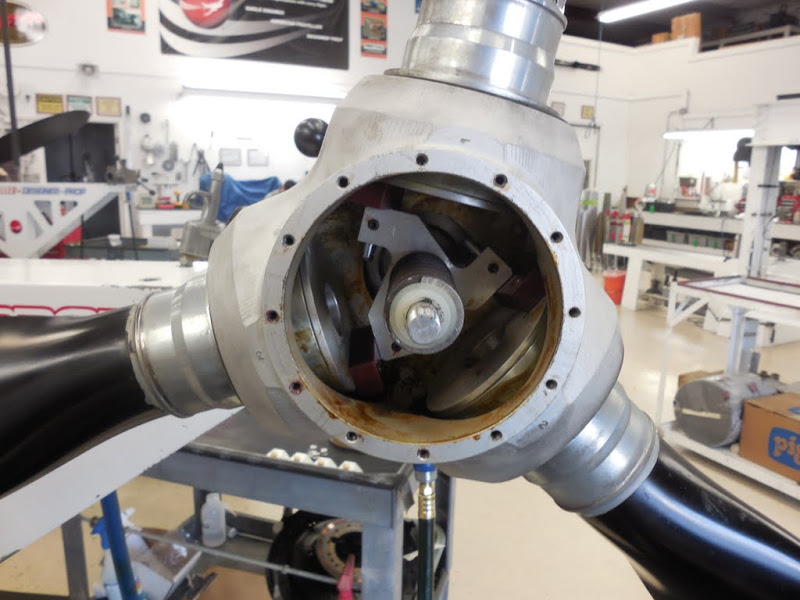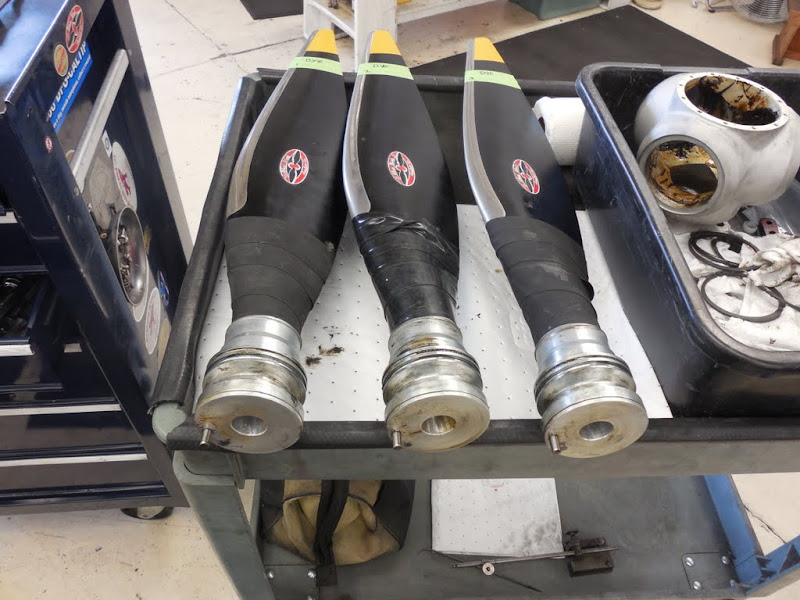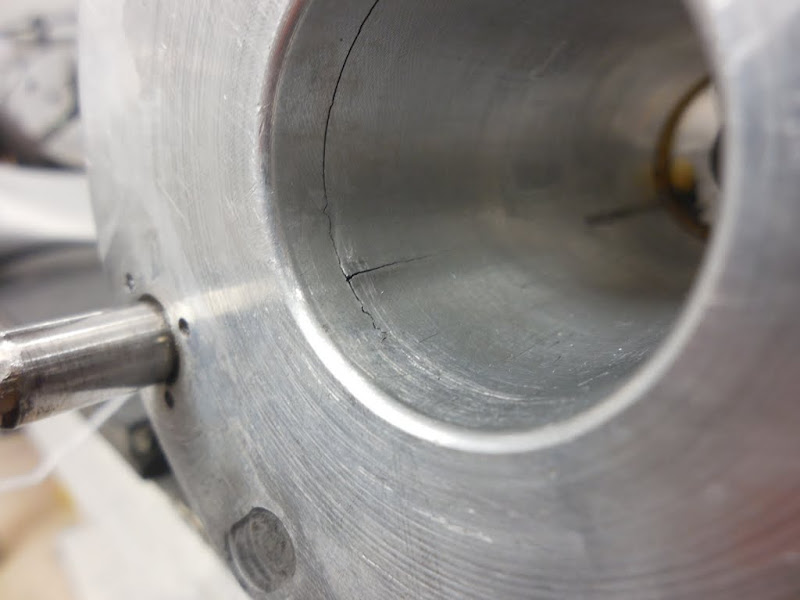I have been a big cheerleader for the Whirlwind 151-H Prop for the RV-3. It provides outstanding performance, gives all the envelope capability of a Constant Speed Prop, is smooth, and best of all ? is light enough for the nose of an RV-3. I found out about it from Randy Lervold?s excellent blog on the building of his RV-3, and have not been disappointed by it in flight. The three-blade prop is not cheap, and there are not a lot of them out in the field. There were some issues early on with the original blades (made with aluminum ferules) when used on IO-360?s, and Whirlwind came out with new blades fitted with steel ferules. This has apparently stopped the problems with fretting between the ferule and the hub. Because there is not a lot of field experience, with the prop, it has a very short service interval set at 350 hours. Ahh?the price we pay for being early adopters.
When we reached 350 hours in about two years of operation, I talked with the prop?s designer, Jim Rust, about going longer based on other?s field experience. He said that he had well over 400 hours on his, and was seeing no issues, so we elected to go longer to help expand the database. We had a similar discussion with Whirlwind, Jim, and Ameritech Propellers in Redding (CA) at 450 hours, and the consensus was that if it wasn?t spitting grease, run it a bit longer. At 500 hours, I found some grease on a blade after a flight, so we called Ameritech, and had them come pick it up.
Unfortunately, the teardown inspection found a problem that Jim and Whirlwind?s Greg Andersen say they have not seen before ? cracks in an aluminum ?cap? that closes out the interior of the blade root inside the hub. This part, shaped like a stove-pipe hat, sits inside the hollow root of the blade, and they found cracks on all three of ours. There was also a slight groove worn into a sealing surface on the hub (unrelated to the cracks), and Whirlwind had a routine sleeve fix for that. Unfortunately, the blades were considered unserviceable, and had to be replaced. If I understand the dynamics of the mechanical assembly correctly, the cracks were not a threat in terms of throwing a blade or massive structural failure ? but it certainly was not something that we wanted to see. Jim Rust made the new blades at his shop in San Diego and shipped them and the hub to Whirlwind in Ohio for the hub machining and reassembly. The prop is on its way back right now, and we should be flying the RV-3 again later this week.
Props are something that have to be right ? the consequences of failure are often catastrophic. I am comfortable that we were not on the way to shedding a blade, and Greg at Whirlwind told me that they have at least one customer with this prop who uses it on a daily commuter, putting on over 2,000 hours to date. They claim to have never seen this problem before, and I have no reason to dispute that. These three blades were all made at the same time ? so was there a manufacturing or materials defect that affected them all equally? Everyone involved finds it hard to believe that the extended time between overhaul would have made a difference, since the overhaul process would not affect whether the part would crack or not ? if it was not cracked when they opened it up, it would just have cracked afterwards. We are flying this on an IO-320 with P-Mags, normal compression. While the prop is now not recommended for use on 360?s with high compression pistons or electronic ignitions, both Greg and Jim think we should be fine in our configuration.
We?re going to fly the prop again (its essentially new), basically because we have yet to find a viable replacement that will give us the performance for the weight that we get from the 151 ? but we are going to open it up at the early service interval and see what we find. Some might say that it is foolish to fly with a design that has been known to crack ? but we frequently repair and fly cracked engine cases ? and we?re going to be flying with all new blades. Meanwhile, we?ll see what might be on the market today that can do the same job at the same weight. Like I said at the start ? this is really a great performing prop ? but we knew going in that we were early adopters and as such, we had to be prepared for surprises. Hopefully, we?ll find that there was something unique to this batch of blades (built in early 2011 I think), and we won?t see this next time ? but we?ll be watching carefully.
Meanwhile, if there are any other WW-151 users out there, it might be time to have a look inside and see if anything is amiss ? that is the real purpose of this post?.to get the word out. Jim at Whirlwind Propellers and Greg at Whirlwind Aviation have been absolutely stellar to work with on this issue, and they have bent over backwards to get us back in the air as quickly and inexpensively as possible. But such are the realities of experimental aviation ? there are always going to be unknowns, and you have to go in with your eyes wide open.
Pictures:
Here is the prop with the cover plate removed. You can see that the blades are secured in the hub by the steel blade ferules ? you can just see the aluminum ring at the very base of the blades that form the brim of the ?stove-pipe hat? that closes out the root end of the blade.

All three blades as removed from the hub. As I understand it, the pitch-change lug (the pin sticking out the base of the blades) is secured deeply into the steel ferule, and there is simply a hole in the aluminum stove-pipe hat that passes over it ? so failure of the aluminum brim doesn?t affect that directly ? although it could clearly create something loose in the hub that could interfere with operation.

Here?s one of the cracks ? basically, the ?brim? of the hat is separating from the top part that extends into the hollow blade root. Certainly not pretty!

Folks ? if you are flying with one of these, get it inspected ? let?s find out if this is an isolated incident, or if we have a systemic problem!
When we reached 350 hours in about two years of operation, I talked with the prop?s designer, Jim Rust, about going longer based on other?s field experience. He said that he had well over 400 hours on his, and was seeing no issues, so we elected to go longer to help expand the database. We had a similar discussion with Whirlwind, Jim, and Ameritech Propellers in Redding (CA) at 450 hours, and the consensus was that if it wasn?t spitting grease, run it a bit longer. At 500 hours, I found some grease on a blade after a flight, so we called Ameritech, and had them come pick it up.
Unfortunately, the teardown inspection found a problem that Jim and Whirlwind?s Greg Andersen say they have not seen before ? cracks in an aluminum ?cap? that closes out the interior of the blade root inside the hub. This part, shaped like a stove-pipe hat, sits inside the hollow root of the blade, and they found cracks on all three of ours. There was also a slight groove worn into a sealing surface on the hub (unrelated to the cracks), and Whirlwind had a routine sleeve fix for that. Unfortunately, the blades were considered unserviceable, and had to be replaced. If I understand the dynamics of the mechanical assembly correctly, the cracks were not a threat in terms of throwing a blade or massive structural failure ? but it certainly was not something that we wanted to see. Jim Rust made the new blades at his shop in San Diego and shipped them and the hub to Whirlwind in Ohio for the hub machining and reassembly. The prop is on its way back right now, and we should be flying the RV-3 again later this week.
Props are something that have to be right ? the consequences of failure are often catastrophic. I am comfortable that we were not on the way to shedding a blade, and Greg at Whirlwind told me that they have at least one customer with this prop who uses it on a daily commuter, putting on over 2,000 hours to date. They claim to have never seen this problem before, and I have no reason to dispute that. These three blades were all made at the same time ? so was there a manufacturing or materials defect that affected them all equally? Everyone involved finds it hard to believe that the extended time between overhaul would have made a difference, since the overhaul process would not affect whether the part would crack or not ? if it was not cracked when they opened it up, it would just have cracked afterwards. We are flying this on an IO-320 with P-Mags, normal compression. While the prop is now not recommended for use on 360?s with high compression pistons or electronic ignitions, both Greg and Jim think we should be fine in our configuration.
We?re going to fly the prop again (its essentially new), basically because we have yet to find a viable replacement that will give us the performance for the weight that we get from the 151 ? but we are going to open it up at the early service interval and see what we find. Some might say that it is foolish to fly with a design that has been known to crack ? but we frequently repair and fly cracked engine cases ? and we?re going to be flying with all new blades. Meanwhile, we?ll see what might be on the market today that can do the same job at the same weight. Like I said at the start ? this is really a great performing prop ? but we knew going in that we were early adopters and as such, we had to be prepared for surprises. Hopefully, we?ll find that there was something unique to this batch of blades (built in early 2011 I think), and we won?t see this next time ? but we?ll be watching carefully.
Meanwhile, if there are any other WW-151 users out there, it might be time to have a look inside and see if anything is amiss ? that is the real purpose of this post?.to get the word out. Jim at Whirlwind Propellers and Greg at Whirlwind Aviation have been absolutely stellar to work with on this issue, and they have bent over backwards to get us back in the air as quickly and inexpensively as possible. But such are the realities of experimental aviation ? there are always going to be unknowns, and you have to go in with your eyes wide open.
Pictures:
Here is the prop with the cover plate removed. You can see that the blades are secured in the hub by the steel blade ferules ? you can just see the aluminum ring at the very base of the blades that form the brim of the ?stove-pipe hat? that closes out the root end of the blade.
All three blades as removed from the hub. As I understand it, the pitch-change lug (the pin sticking out the base of the blades) is secured deeply into the steel ferule, and there is simply a hole in the aluminum stove-pipe hat that passes over it ? so failure of the aluminum brim doesn?t affect that directly ? although it could clearly create something loose in the hub that could interfere with operation.
Here?s one of the cracks ? basically, the ?brim? of the hat is separating from the top part that extends into the hollow blade root. Certainly not pretty!
Folks ? if you are flying with one of these, get it inspected ? let?s find out if this is an isolated incident, or if we have a systemic problem!




